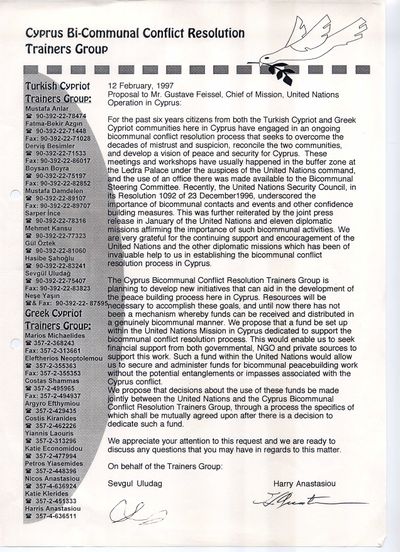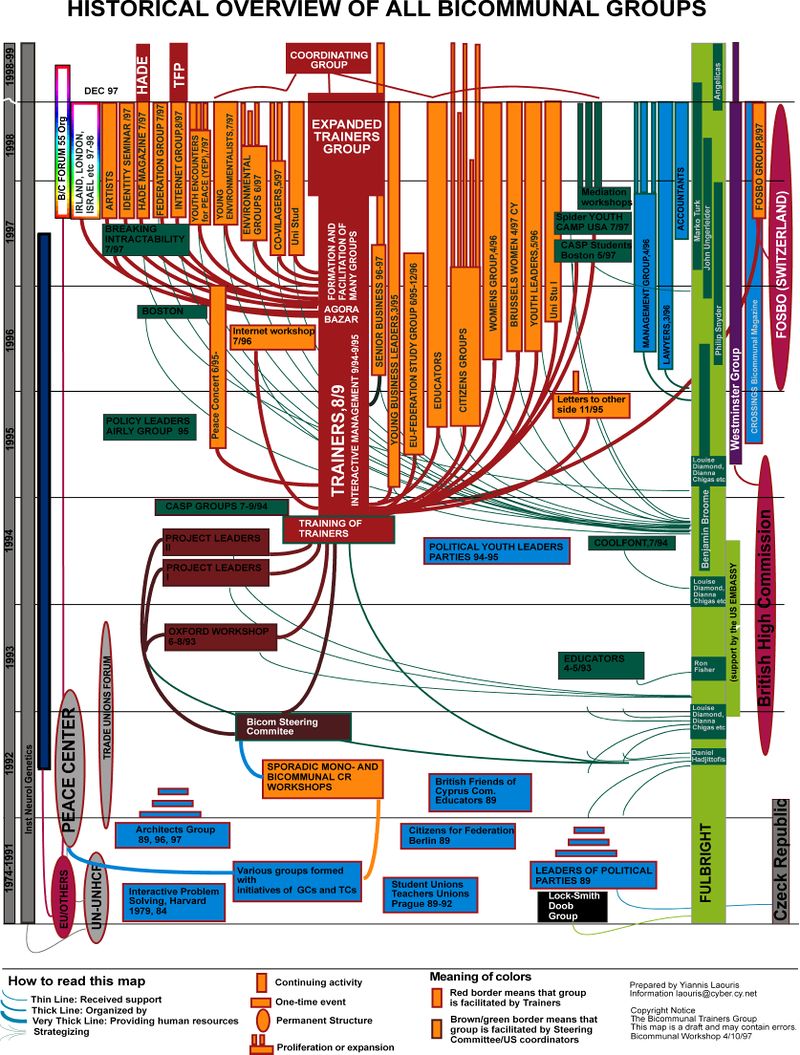Future Worlds Center: A pioneer in peace initiatives
Future Worlds Center, earlier known as Cyprus Neuroscience and Technology Institute, together with its technology partner CYBER KIDS has engaged in peace-related initiatives as early as 1994. Its founder, Yiannis Laouris was one of the participants of early peace projects such as The Westminster Group, Bicommunal Conflict Resolution Group (Project Leaders I), Bicommunal Conflict Resolution Group (Project Leaders II), and Cyprus Conflict Resolution Trainers Group. Between 1994 and 1997, the center has provided generous logistical and technological support, and has also hosted countless meetings. Harry Anastasiou, another historic member of many early peace initiatives and especially the Cyprus Conflict Resolution Trainers Group[1], which is credited for the formation of the embryonic peace movement in Cyprus, has joined powers when Harry was invited to join CYBER KIDS as Head of the CYBER KIDS Curriculum Development Unit[2].
Peace Initiatives between 1994 and 1999
Harry and Yiannis have coordinated and trained several early peace initiatives. Together with virtually all members of the Cyprus Conflict Resolution Trainers Group, they are credited for the training of over 4,000 citizens in peace and conflict resolution, summarised in the map below. They served as initiators and/or trainers of almost a dozen of those groups. In these early trainings, they have applied Interactive Management, the methodology they have learned from their participation in the Cyprus Conflict Resolution Trainers Group and especially from Benjamin Broome, a student of John N. Warfield. Interactive Management is the predecessor of what later became knows as Structured Democratic Dialogue.
The work of this group culminated with the decision to request the formal support if the UN sent in the form of a letter in February 1997.

The letter was signed by Harry Anastasiou, at the time already member of the Board of Future Worlds Center, on behalf of the Greek Cypriot community. Sadly, it took the UN almost 3 years to put in place a funding support scheme. By December 1997 all bi-communal meetings were banned by the Turkish Cypriot Authorities following the EU’s decision to postpone accession negotiations with Turkey (summit meeting in Luxembourg, December 1997). Harry and Yiannis
The creation of Technology for Peace portal has built on an early initiative that started in July 1996, when Yiannis Laouris, Mustafa Anlar, Lefteris Neoptolemou and Dervis Besimler all members of the Cyprus Conflict Resolution Trainers Group, planned and materialized an Internet Workshop for students[2]. Subsequently, in August 1997, Laouris and Anastasiou (from the Greek Cypriot side) in coordination with their counterparts in the North, Dervis Besimler and Bekir Azgin, together with other members of the Technology for Peace Initiative from both communities founded the internet group, which became known as Tech4Peace. In July 1998 Technology for Peace held its first Internet Training Workshop in Nicosia, Cyprus. This training workshop was jointly organized by the Institute of World Affairs in Washington, D.C., and the Technology for Peace Group in Nicosia, Cyprus.
In 1997, a USAID grant ($12,000 for the Greek Cypriot side) to Dr. Hrach Gregorian of the Institute of World Affairs[3], who has been collaborating with the two sides of the Tech4Peace initiative, was used to purchase for two computers, in the South and four in the North, a server in the States, rent for space and internet fees for six months, and modest facilitators' remunerations. Following two parallel workshops, and a follow-up for a six-month period of virtual negotiations in the context of the ICONS Project of the University of Maryland allowing Turkish- and Greek- Cypriots to participate in virtual negotiation workshops at a time when crossing the border was not possible[4],[5]) and communication, the project was brought to existence and its significance and contributions became visible. Tech4Peace enjoyed the enthusiastic support of the USAID representation in Cyprus Mrs. Judith Baroody, it received great and positive attention by the media, by diplomats and of course, more importantly, it was embraced by the peace builders of both sides who gradually saw the potential and opportunity provided by cyberspace. A small follow-up grant by the USIP ($6,000 for GC side) supported the purchase of two additional computers, and paid for internet connection fees during a workshop that took place in the summer of 1998. This workshop signalled the new revised strategy of the initiative, which was to involve and train active members of bicommunal groups so that they could benefit from the potentials and advantages that virtual cyberspace infrastructures had to offer.
stopped our face-to-face dialogues and threatened to nullify all peace building efforts. An alternative means of communication across the border became necessary. At the same time, notwithstanding its status as a developed/ing country, Cyprus was one of the last countries to connect to the Internet. This was partly because of a monopoly of the state-owned Telecommunications Company and partly because of the communications embargo imposed by the authorities.
In
The project Technology For Peace (Tech4Peace) was envisioned and implemented in order to enhance one of the most basic human rights, the right of communication across the military barriers in Cyprus. It was "born" because it was needed. What led to its birth was neither the availability of relevant technology nor the availability of funding, because both were simply not there!
, it has proposed to the Planning Bureau the creation of a bicommunal internet service provider. The American Ambassador
